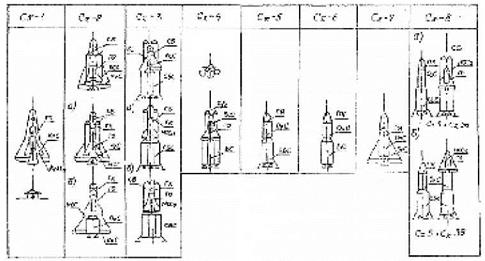The Soviet response to NASP
Research on aerospace planes in the Soviet Union got a fresh impetus in the mid-1980s, presumably in response to similar work started in the US in 1982 at the Defense Advanced Research Projects Agency (DARPA) under the name Copper Canyon and then transferred to NASA and the Air Force as the National Aerospace Plane (NASP) in 1986. President Ronald Reagan mentioned the project in his State of the Union speech on 4 February 1986, calling it:
“a new Orient Express that could, by the end of the next decade, take off from Dulles Airport, accelerate up to 15 times the speed of sound, attaining low Earth orbit or flying to Tokyo within two hours.’’
Although touted by the Reagan Administration for its civilian commercial applications and as a possible follow-on to the Space Shuttle for NASA, the 80-20 split of funding between the Air Force and NASA clearly indicates NASP was first and foremost a military program. The objective of the program was to develop a prototype SSTO vehicle taking off with turbojets, then switching to hydrogen-fueled scramjets at subsonic and hypersonic speeds, with a LOX/LH2 rocket engine performing orbit insertion.
The go-ahead for the Soviet response came in two government decrees on 27 January and 19 July 1986, followed by the release of technical specifications by
|
The Tu-2000. |
the Ministry of Defense on 1 September 1986. Three organizations were tasked to come up with proposals: NPO Energiya, the Yakovlev bureau, and the Tupolev bureau. While nothing is known about the Yakovlev concept, NPO Energiya’s aerospace plane was a 71 m long vehicle with a wingspan of 42 m and a maximum height of 10 m. With a take-off mass of approximately 700 tons (dry mass 140 tons), the vehicle would use a combination of turbojets, scramjets, and rocket engines to reach orbit. It was designed for the deployment of payloads into low orbits (at least 25 tons into a 200 km, 51° orbit), servicing of orbital complexes, intercontinental passenger transport and also for military operations “in and from orbit’’. The project was headed by veteran designer Pavel Tsybin [20].
The project eventually selected for further development was the Tupolev bureau’s Tu-2000. Actually, the bureau was no newcomer to SSTO vehicles, having already performed low-priority studies of horizontal take-off and landing space – planes with a take-off mass of up to 300 tons in 1968-1971. Overall Tu-2000 was very similar in design to NASP, relying on the same combination of engines to go into orbit. It had a vertical stabilizer and small delta wings, with much of the lift provided by the flat-shaped underside of the fuselage. A huge hydrogen tank occupied most of the mid and aft fuselage and would feed both the scramjet and rocket engines. The oxygen tank for the rocket engine was located in the tail section.
The Tupolev bureau proposed to carry out the project in two stages. First, it would develop a 55-60 m long two-man suborbital demonstrator (Tu-2000A) to reach a maximum velocity of Mach 5/6 and an altitude of up to 30 km. With a take-off mass between 70 and 90 tons, the vehicle would be equipped with four turbojet engines, two scramjets, and two liquid-fuel rocket engines. Then the project would move on to an experimental 71 m long two-man orbital version with a take-off mass between 210 and 280 tons and six rather than four turbojet engines. Payload capacity was 6-10 tons to low orbits between 200 and 400 km. Unconfirmed reports suggest the Tupolev bureau also planned a long-range bomber (Tu-2000B) and a hypersonic passenger plane based on the Tu-2000 design.
By the early 1990s the Tupolev bureau had reportedly built a wing torque box made of a nickel alloy, elements of the fuselage, cryogenic fuel tanks, and composite fuel lines. Estimates made in 1995 showed that Tu-2000 related R&D would cost at least $5.29 billion, a high price-tag even if Russia had a healthy economy. Budget realities had also forced NASA and the Air Force to cancel NASP in 1993. Although low-level research on the Tu-2000 may have continued for several more years, this project obviously stands no chance of being realized any time soon [21].











